Taekwondo 태권도Taekwondo Preschool
Joseon was a Korean state founded by Taejo Yi Seong-gye that lasted for approximately five centuries, from July 1392 to October 1897. It was founded following the aftermath of the overthrow of the Goryeo Dynasty in what is today the city of Kaesong. Early on, Korea was retitled and the capital was relocated to modern-day Seoul. View Joseon Era 조선 »
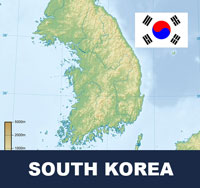
Flag of South Korea
( 태극기 )
The Flag of South Korea, or Taegukgi (sometimes also romanized as Taegeukgi) is the national flag for the Republic of Korea. It has three parts: a white background, a red and blue Taeguk, which is a red and blue Taiji yin- and yang-symbol in the center, and four black trigrams, which are selected from the original eight, on each corner of the flag.
- Adopted - March 6, 1883 (Original Version)
- Adopted - July 12, 1948 (Current Version)
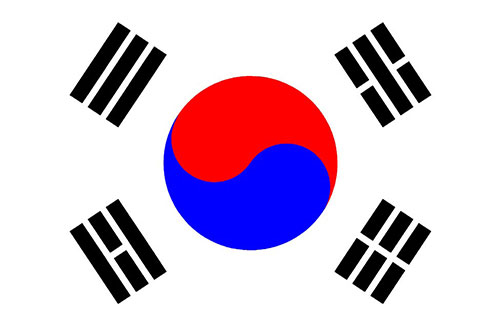
Design
The white background is a traditional Korean color. It represents peace and purity. The circle in the middle is derived from the philosophy of yin and yang and represents the balance of the universe. The blue section represents the negative cosmic forces, and the red section represents the opposing positive cosmic forces. The trigrams together represent the principle of movement and harmony. Each trigram (hangul: kwae) represents one of the four classical elements.
The four trigrams are:
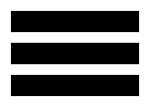
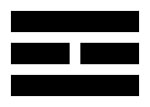
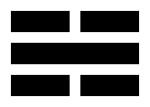
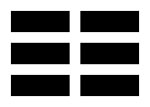
| Name in Korean | Nature | Seasons | Cardinal directions | Four virtues | Family | Four elements | Meanings | |
|---|---|---|---|---|---|---|---|---|
 |
geon (건 / 乾) |
sky (천 / 天) |
spring (춘 / 春) |
east (동 / 東) |
humanity (인 / 仁) |
father (부 / 父) |
heaven (천 / 天) |
justice (정의 / 正義) |
 |
ri (리 / 離) |
sun (일 / 日) |
autumn (추 / 秋) |
south (남 / 南) |
justice (의 / 義) |
daughter (녀 / 女) |
fire (화 / 火) |
fruition (결실 / 結實) |
 |
gam (감 / 坎) |
moon (월 / 月) |
winter (동 / 冬) |
north (북 / 北) |
intelligence (지 / 智) |
son (자 / 子) |
water (수 / 水) |
wisdom (지혜 / 智慧) |
 |
gon (곤 / 坤) |
earth (지 / 地) |
summer (하 / 夏) |
west (서 / 西) |
courtesy (예 / 禮) |
mother (모 / 母) |
earth (토 / 土) |
vitality (생명력 / 生命力) |
History
The lack of the national flag only became an issue in 1876, in the Joseon Dynasty. Before 1876, a national flag did not exist and it was not considered important. The issue began during the negotiations for the Japan-Korea Treaty of 1876. Although the delegate of the Empire of Japan had the Japanese national flag, Joseon Dynasty could not hang a corresponding flag. Thus, there were some proposals to create a flag, but the issue was considered unimportant by the government. At 1880, the proliferation of foreign negotiations led to a need for the national flag. The most major proposal was described in the ‘Korea Strategy’ papers written by the Chinese delegate Huang Zunxian. The proposal was to incorporate the Flag of the Qing Dynasty for the Joseon Dynasty. In response to the proposal, the government sent the delegate of Lee Young-Sook to explore the possibility of the issue through the politician Li Hongzhang. Li Hongzhang agreed with some parts of the proposal, but proposed that some other factors should be differed. The Qing Dynasty agreed with Hongzhang, but it is unknown how far the Joseon government explored this proposal
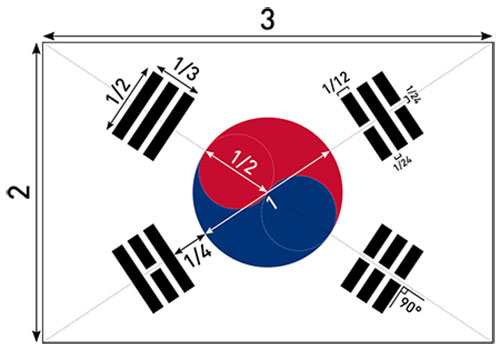
The issue was then shelved, and reemerged with the ratification of the United States-Korea Treaty of 1882. The controversy arose after the delegate Lee Eung-Jun presented a flag similar to the flag of Japan to the Chinese official Ma Jianzhong. In response to the discussion, Ma Jianzhong argued against the proposed idea of using the Flag of the Qing Dynasty and proposed a flag with a white background, with a half-red and half-black circle in the center, with eight black bars around the flag. On August 22, 1882, Park Yeong-hyo created a scale model of the Taegukgi to the Joseon government. Park Yeong-hyo became the first person to use the Taegukgi in the Empire of Japan on 1882. On January 27, 1883, the Joseon government officially promulgated Taegukgi to be used as the official national flag.
Before the division of Korea, the current South Korean flag was used for the entire country. However, after the separation, the flags divided into Flag of South Korea and the Flag of North Korea. The current Korean flag was declared official by the government of South Korea on October 15, 1949.
Dimensions
The width and length is in the ratio of 3 to 2. There are five sections on the flag, the taegeuk and the four groups of bars. The diameter of the circle is one-fourth of the diagonal. The top of taegeuk should be red and the bottom of taegeuk should be blue. The groups of bars are put in the four corners of the flag.
Colors
The colors of Taegukgi are specified on the "Ordinance Act of the Law concerning the National Flag of the Republic of Korea."(대한민국 국기법 시행령). There were no specification for shade of colors until 1997, when South Korean government decided to provide standard specification for the flag. On October, 1997, Presidential ordinance on the standard specification of the flag of the Republic of Korea was promulgated, and that specification was acceded by the National Flag Law in 2007.
The colors are defined in legislation by the Munsell and CIE color systems:
| Scheme | Munsell | CIE (x, y, Y) | Pantone | Hex triplet |
|---|---|---|---|---|
| White | N 9.5 | N/A | N/A | #FFFFFF |
| Red | 6.0R 4.5/14 | 0.5640, 0.3194, 15.3 | 186 Coated | #C60C30 |
| Blue | 5.0PB 3.0/12 | 0.1556, 0.1354, 6.5 | 294 Coated | #003478 |
| Black | N 0.5 | N/A | N/A | #000000 |
Early Taegukgi
Taegukgi of the Joseon Dynasty (before 1800). Flag of the king of Joseon. Its name is Eo-gi(어기) in Korean. This flag is in the Kyujanggak, Seoul National Univ.
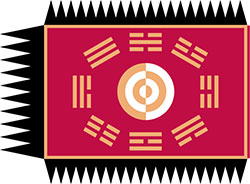
Taegukgi of the Joseon Dynasty, King Jeongjo (ca. 1800). Flag of the Joseon Dynasty
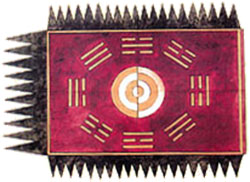
Flag of the Joseon Dynasty (Qing Empire tributary, March 1883
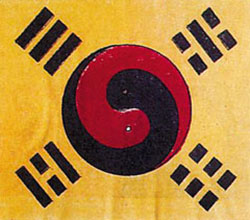
Taegukgi by Park Yeong-hyo (September 1882)
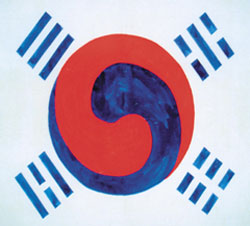
Taegukgi (November 1882)
1882년 11월작 태극기
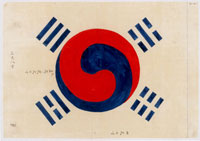
Taegukgi (1910)
left-right flipped flag of the Joseon Dynasty
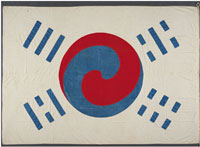
Taegukgi on a U.S. postage stamp (1944)
Detail of United States postage stamp (released in November 1944) from the "Overrun Countries series", showing the pre-1905 flag of Korea (similar to the modern flag of South Korea).
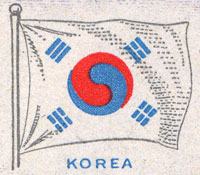
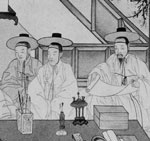
Korea ( 한국 )
Korea ( 한국 ) called Hanguk in South Korea and Chosŏn in North Korea, is an East Asian territory that is divided into two distinct sovereign states, North Korea and South Korea. Located on the Korean Peninsula, Korea is bordered by China to the northwest and Russia to the northeast. It is separated from Japan to the east by the Korea Strait and the Sea of Japan (East Sea). For more information View Korea ( 한국 ) »
RESOURCES
This article uses material from the Wikipedia article "Flag of South Korea", which is released under the Creative Commons Attribution-Share-Alike License 3.0.









